This website uses cookies so that we can provide you with the best user experience possible. Cookie information is stored in your browser and performs functions such as recognising you when you return to our website and helping our team to understand which sections of the website you find most interesting and useful.
Each day, users turn to Google to find an answer.
In fact, 8.5 billion answers.¹
With every search comes an insight into user intent. Whether they are looking for a piece of clothing or seeking advice from an article, we know they want something. The art lies in serving the right advertisement, at just the right time.
Google Search Ads offer an effective way to target individuals who are at a critical point in their decision-making process. Requiring a specific service? Here are a selection of businesses to get you started, and conveniently, they are in your local area!
A staggering 65% of users² click on ads when looking to make a purchase. Their subtle integration into the Google SERP architecture is a valuable opportunity to capture customers – especially within a competitive landscape.
Google Ads formats and their benefits
There are several types of Google Ads, which are designed to help businesses reach their target audience in various ways. The most common types of Google Ads are:
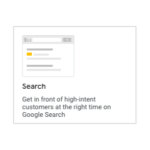
Search Ads
These are the most broadly used format of Google Ads, which appear on the Google search engine results page (SERP) when someone searches for a specific keyword or phrase. These ads are text-based and can include ad extensions such as sitelinks, callouts, and call extensions. These ads are highly targeted and can help businesses reach potential customers who are actively searching for their product or service, increasing website traffic, lead generation, and sales.
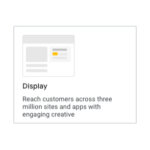
Display Ads
Display Ads are visual ads that appear on websites and apps, as part of the Google Display Network. These ads can include images, videos, or HTML5 animations and can be targeted based on audience demographics, interests, and behaviours. Designed to increase brand awareness and reach a wider audience, they can help businesses retarget website visitors and previous customers, driving higher conversion rates through repetitive brand exposure.
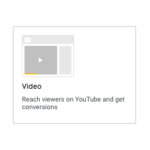
Video Ads
Video Ads appear on YouTube and other Google Display Network partner sites. These ads can be set to ‘skippable’ (or alternatively locked in) and can be targeted based on audience demographics, interests, and behaviours. Often highly engaging, video ads help businesses reach a large audience on YouTube, the second-largest search engine after Google.
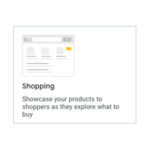
Shopping Ads
Shopping Ads appear in Google search results when a user has used a query relating to purchase. They can also help drive higher click-through rates and sales, as the ads provide detailed information about the product, including price and reviews. With the ad layout featuring an image, customers are quickly able to make judgement if the product suits their needs – leading them faster and further down the sales funnel than most other ad types.
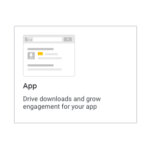
App Ads
App Ads promote mobile apps on Google search results, Google Play, YouTube, and other Google Display Network partner sites. These ads can include images, videos, and call-to-action buttons. App ads can help increase app downloads and user acquisition by reaching a wider audience, especially when viewed from a mobile device.
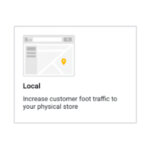
Local Ads
Local Ads promote geographically, local businesses on Google search results, Google Maps, and other Google Display Network partner sites. These ads can include location information, business hours, reviews, and directions, helping increase foot traffic and store visits. However, is important to keep in mind the consumer expectation with this ad type. Customers require answers – all the answers. Which requires a listing with every section complete, whether that is directions, reviews, or opening times. With these present at first glance, users can be easily impacted.
Each ad type has its own unique application and benefits; therefore, it is important to first understand whether this platform is relevant to your target audience personas and how this approach can help achieve commercial goals.
Benefits of using Google Ads
Driving instant, targeted brand visibility
Although a lengthier process, we cannot ever disregard SEO strategies in elevating key landing pages higher within SERP rankings. Having authority in the organic space will increase awareness and credibility, leading to organic clicks. There is no bidding involved, so these methods are free of any media spend and when implemented strategically, can attract high volumes of traffic to the website.
However, Search Ads are usually triggered within their respective results pages after 24 hours of being published – it’s that quick. If your ads are relevant and budget is set correctly to the competitiveness of keywords and their average search volume, you are likely to sit adjacent to similar brands within the top ad-allocated spaces. If keywords are kept relevant through regular maintenance, the traffic from searches will be consistently valuable.
In short, a collaborative approach to search engine optimisation is ideal.
Relying solely on SEO or PPC can be risky, as changes to search engine algorithms or ad platforms can significantly impact website traffic. By leveraging the power of both channels simultaneously, businesses can diversify their traffic sources and often reduce the risk of relying on a single channel.
Brand awareness with Google Ads
It’s not all about the clicks. Triggering ads to appear within the SERP can result in increased brand awareness for your business. Ads can still resonate with and capture the attention of users for topics they are have shown active intent for, though may not earn a click. After a week, when they see a post from your company on social media, they have instant recall because they were previously exposed to your brand through a different marketing touchpoint.
This is where ad content is a priority. Ads are a soapbox to inform the searcher about how your offerings can provide value for their precise requirements.

Competitive advantage with Google Ads
Building organic domain authority for certain keywords can take time. Especially when set against legacy brands with infinite budgets. Google Search Ads can result in parity with your competitors, positioning your content adjacent to those also bidding on the same keywords – or even above organic search results of other businesses within your industry.
Competitor keyword targeting can reinforce this. Keyword targeting allows you to bid on business or brand terms. Whilst a much more tactical and assertive approach, this method positions your organisation within the search results for competitor brand names, providing the user with choice and alternative options.
Regardless of whether your ads earn clicks for these terms, or users remain brand loyal to your competitors – your business becomes positioned within that competitive space and may plant the seed for future searches.
Conclusion
Google Ads are a valuable traffic source, with the potential to yield high ROI when implemented correctly. As the advertiser holds complete control over their ads and spend, the results are in your hands.
To ensure you’re getting the most for your budget, forecast your targeting preferences when considering allocating budget towards Google Search Ads. Your investment will determine the results you receive from your ads.
Are you getting started with Google Ads and acquiring valuable traffic? Discover how TMC collaborates with businesses to reach their potential with our Campaign solutions.
References:
- https://www.oberlo.com/blog/google-search-statistics
- https://thesocialshepherd.com/blog/google-ads-ppc-statistics
Share this

